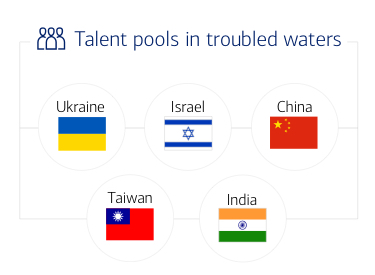tech outlook Taking the long view is more important than ever
For tech companies, pulling back from an international presence is not an option. Instead, thinking ahead, de-risking and making smart decisions about where and how to work are key.


9 minute read
Key takeaways
- Tech companies are more international than ever, opening them up to new opportunities.
- The need to be international outweighs the challenges, but strategies for navigating an uncertain environment are essential.
- Leveraging local relationships can help with de-risking.
- Shockproofing now can leave tech companies better off when growth accelerates again.
Technology exists largely in a world without borders; most tech companies are inherently global. That uniquely global quality, combined with its role as the growth engine for many economies, means the tech sector has been front and center in 2025’s headlines.
It also means that the real-world issues of being a global technology organization — whether that’s making an overseas acquisition, recruiting talent, sourcing product, opening a factory, establishing a new market or managing money — feel more complicated in today’s uncertain economic landscape.
“Today’s companies themselves are more global, more international than they have ever been,” says Paul Taylor, head of the International Commercial Bank for Bank of America. “They are more dependent on worldwide supply chains. U.S. companies in the internet age make a far greater proportion of their revenues from overseas sales. And that is true in no industry more than technology. For a lot of these companies, their business case is based on the premise that they will be able to serve an international client base. That means they are more exposed to international opportunities and challenges than ever before.”
Despite the current backdrop of protectionism, trade wars and currency fluctuations, for most tech companies, “The need to be international will outweigh the challenge of being international,” says Jeff Minick, Transformative Technology Group executive, at Bank of America. But how do tech executives manage those challenges?
De-risking and shockproofing
For most technology companies, pulling back from an international presence is not an option. Instead, the assignment is making smart decisions about where and how to work, and reducing the risks inherent in being a global company.
“The best thing that a technology company can do in this environment is to think about the long-term play,” says Minick. “Stick with your strategy. Don’t deviate. Remember: We have seen this movie before. What is live and real today may not be real in three or six months, so don’t let “breaking news” guide your company’s long-term strategy.”
“The best thing that a technology company can do in this environment is to think about the long-term play.”
Minick does say that sourcing may change for some tech companies, and that hardware companies may be forced to rethink production locations. “Part of what we’re seeing is that matching the location of your revenues and costs might become a more important consideration in future plans,” he says. “Tech companies are going to go where the customer is.”
But even in the current high-pressure environment, he stresses, “Each company needs to know that the reason for doing business in a country can’t be one-dimensional, and that decisions should be made for the long term.”
A company might choose to enter a country to create a new production facility, to access engineering talent, to increase distribution capacity or to open a new consumer market—and ideally, to accomplish more than one of those goals. No matter what the reasons for expanding into a new market, a U.S.-based company doing business in a foreign jurisdiction needs to have a good dialogue with regulators in that country, and also a good understanding of how that market works.
Sometimes that familiarity comes from the founder, a key executive or an acquired talent — someone who hails from that country or at least is acquainted with it. Sometimes the familiarity comes from partners who have built local operations with multilingual capabilities — who can keep track of regulations, policies and politics country by country.
Those connections also provide an element of de-risking. “If you have someone who knows the talent, the culture, the government, there’s a lot less risk than if you have to rely on someone outside the company to help you navigate all of that,” Minick says. “Like it or not, even tech comes down to personal connections. In the current environment, those local relationships are more important than ever — you need to do that better than ever.”
“If you have someone who knows the talent, the culture, the government, there’s a lot less risk than if you have to rely on someone outside the company to help you navigate all of that.”
Financially, to protect themselves from global volatility, companies need to make sure they are adequately capitalized in the right places, with the right currency and the ability to move that currency when needed. Working with global providers is one way to make it easier to operate efficiently in markets around the world — and there are fewer truly global financial companies than ever.
“The number one thing we see U.S.-based tech companies do is to consolidate banking with one or two providers so that it’s easier to get a hold of global cash and allow it to flow between countries and entities. That provides one global view of cash. The alternative is to enter a new country, partner with lawyers who have relationships with local banks, use that local bank to set up the organization and then grow. And then the business has a one-off bank. Doing that 15 times in 15 countries leaves you with different ERP and accounting system integrations or manual data access, data spread out all over — making it complicated for cross-country flows and complicated to get a macro view of your business,” Minick says.
In terms of financial operations, Taylor says, “Shockproofing is probably needed right now. If you are a CFO or CEO or global treasurer, you need to look to make sure all your financial arrangements are shock-resistant. You want to be shockproof on the cash side, but also asking yourself this: Do I have the right facilities in place in the right currencies in the right countries to give me the predictability I need to support my business in the medium to long term? Given the current environment, you’re probably looking for more than a natural hedge.” That’s especially true given the potential impact of the United States’ relationship with the rest of the world on the dollar’s role as the world’s reserve currency and foundation of global payment systems.
“If you are a CFO or CEO or global treasurer, you need to look to make sure all your financial arrangements are shock-resistant.”
Managing the talent
For better or worse, some of the hotbeds for technology talent exist in complicated areas of the world, including Ukraine, Israel, China, Taiwan and India. Israel has established a leadership position in cybersecurity; Ukraine and Poland and other central European countries, plus India, have deep engineering and programming talent.

But as they think global and consider tapping into those overseas talent pools, Minick says, “Tech companies need to look at the ability of governments outside the U.S. to help ensure a stable workforce. We already saw that in Ukraine, where in a month, employees had fled the country — often to Poland — and companies had to find new engineers to pick up the projects that were impacted,” Minick says. “That’s just one example of what tech execs need to be thinking about when going after engineering talent.”
Going overseas can provide a lower explicit labor cost, but Minick says companies need to diversify that overseas workforce. “Don’t have your eggs in one basket. If you are going to run a global business, you need to have engineering talent that is geographically diverse to protect you from geopolitical risk, especially today.”
And then a company needs to consider how the talent will work together across borders — how to bridge language, time and cultural gaps effectively. “You have to be more astute than ever to navigate that.”
Still, he says, if a company can run it well, it is still worth it and more cost-effective to employ international talent and workforces for core programming functions. “The industry’s best talent and engineers are in the U.S., but there are opportunities to leverage global talent for specific functions.”
In addition to outsourcing work, of course, many tech companies go global when they acquire companies. And many of those acquisitions are talent-based. “Companies are going after specific talent because they have seen the company do great work,” Minick says. “But before making a deal, you need to test for the right cultural fit within your company; does the acquisition make cultural sense in addition to financial sense?”
To keep that talent around for four or five years, companies need to properly structure deals. Perhaps the most popular structure is an earn-out agreement, where a portion of the purchase price is paid out if the merged company achieves certain financial goals after a designated amount of time. “It can then be more attractive and more lucrative for the talent to stay on and help drive those results,” Minick says. “But there also is a risk in structuring those earn-outs, in terms of the currency used and potential fluctuations. Be intentional in how you manage that so that it doesn’t end up costing you more than you planned.”
Looking ahead
There is no way around it: The current economic environment is unpredictable. That unpredictability already has affected the tech sector: fluctuating valuations, on-and-off-again tariffs, and cancelled or postponed IPOs and M&A activity. “Markets and companies like certainty,” Minick says. “In this moment, a pause might be a good thing; wait to see where the dust settles if you can. Some can’t.”
He spies a silver lining. “If you look through the short-term pain, the discipline that will come from moments like this is a good thing for tech companies,” he says. “Tech companies will be better off for having the right rigor in place in terms of business analysis.”
Taylor agrees. “If there’s a slowdown, when it ramps back up, you will be better positioned for outsized growth if you do the work now. And whether it’s driven by the strategies of one country or the state of the global economy, shockproofing has to be a good thing in the long term. As the economy normalizes and growth accelerates again, you’ll have an even bigger advantage than before,” he says.
“If there’s a slowdown, when it ramps back up, you will be better positioned for outsized growth if you do the work now.”
Minick is bullish on the tech sector, no matter the current road bumps. “Tech companies have faster growth, can scale better and faster than other kinds of companies,” he says. “When the current situation normalizes, that will continue to drive investment in them.”
Is AI an evolution or a revolution?
Given the recent breakthroughs in generative AI and the hyper-excitement in the business world and among investors and consumers, every technology company should be assessing its potential to evolve or revolutionize business.




